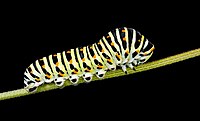
Photo from wikipedia
Abstract Knowledge about the impact of different ecological environments on the composition and function of gut bacteria of Gynaephora species is largely unknown. Here, we characterized the gut bacterial communities… Click to show full abstract
Abstract Knowledge about the impact of different ecological environments on the composition and function of gut bacteria of Gynaephora species is largely unknown. Here, we characterized the gut bacterial communities of the two Gynaephora species (Gynaephora menyuanensis and G. alpherakii) inhabiting different altitudes of the Tibetan Plateau (TP) by 16S rRNA and metagenomic sequencing. We found that G. menyuanensis, which inhabits a lower altitude, had a higher richness in gut bacteria than that of G. alpherakii, which inhabits a higher altitude, whereas G. alpherakii exhibited more unique gut bacteria. The gut bacteria of G. menyuanensis and G. alpherakii were dominated by Proteobacteria and Firmicutes, respectively. Wolbachia and Pseudomonas were significantly more abundant in G. menyuanensis, while Carnobacterium, Enterococcus and Bacillus were more abundant in G. alpherakii. Metagenomic analysis showed that genes involved in metabolism were most enriched in both Gynaephora species. Functional differences were found in four KEGG pathways (metabolism, genetic information processing, environmental information processing, and cellular processes) between the two Gynaephora species. For the metabolism pathway, genes involved in global and overview maps, energy metabolism and metabolism of cofactors and vitamins were more enriched in G. menyuanensis, whereas in G. alpherakii, there was enrichment for genes involved in carbohydrate metabolism, amino acid metabolism and glycan biosynthesis and metabolism. These results indicated that the two Gynaephora species occurring at different altitudes had evident compositional and functional differences in gut bacteria, likely associated with ecological adaptation. Overall, investigation of the composition and function of Gynaephora species opens a new horizon for understanding the gut bacteria, which may provide valuable information about probiotics and control of Gynaephora as a pest.
Journal Title: Science of The Total Environment
Year Published: 2021
Link to full text (if available)
Share on Social Media: Sign Up to like & get
recommendations!